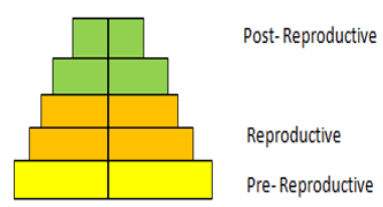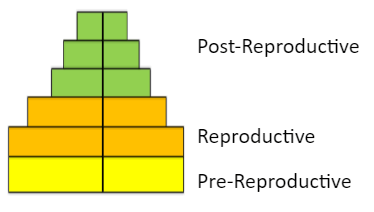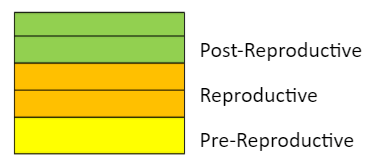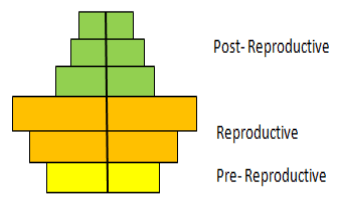This set of Class 12 Biology Chapter 13 Multiple Choice Questions & Answers (MCQs) focuses on “Population Attributes – 2”.
1. Which organisms are considered a population for the purpose of ecological studies?
a) Sexually reproducing organisms
b) Sexually as well as asexually reproducing organisms
c) Asexually reproducing organisms
d) Species
View Answer
Explanation: For ecological studies of population, both sexually as well as asexually reproducing organisms are considered. The organisms formed from sexual reproduction are genetically different (except homozygotic twins). The organisms produced by asexual reproduction are genetically as well as morphologically similar.
2. Which of the following areas do population ecology links?
a) Ecology, population genetics, and evolution
b) Ecology, population genetics, and mathematics
c) Biology, physics and, history
d) Ecology, physics and, history
View Answer
Explanation: Population ecology is a subject that studies the reasons, factors affecting population and how population change over time. It is important for biology conservation and it links ecology with population genetics and evolution.
3. Which of the following attribute does a population have?
a) Births
b) Birth rate
c) Deaths
d) Pyramid
View Answer
Explanation: Among the given above birth rate is a population attribute. It is the number of individuals born in a population at a specific time. For humans, it is described as a number of individuals born per 1000 of the population per year.
4. Which of the following attribute does a population have?
a) Pyramid
b) Births
c) Deaths
d) Death rate
View Answer
Explanation: Among the given above death rate is a population attribute. It is the number of individuals died in a population at a specific time. For humans, it is described as a number of deaths per 1000 of the population per year.
5. Which of the following attribute does a population have?
a) Deaths
b) Births
c) Sex ratio
d) Pyramid
View Answer
Explanation: Among the given above sex ratio is a population attribute. It is the ratio of the number of males versus the number of females. Usually, the tendency of sexually reproducing organisms is to maintain a ratio of 1:1.
6. What does the plot of the age distribution of population results in?
a) Sex ratio
b) Age pyramid
c) Tree
d) Mountain
View Answer
Explanation: When a plot of the age distribution of a population is made it results in a structure called age pyramid. It indicates the growth status of a population and tells whether a population is growing, stable or declining.
7. By which letter is the population density designated?
a) A
b) G
c) F
d) N
View Answer
Explanation: The population density also known as population size is designated by the letter ‘N’. The population density tells about the number of individuals in a unit area (per square meter, per square kilometer or per hectare) at a specific time.
8. At which level does natural selection act?
a) Cellular level
b) Species level
c) Population level
d) Organism level
View Answer
Explanation: Natural selection is a phenomenon that acts at a population level. Natural selection does not create mutations or variations rather it leads to the extinction of individuals who could not adapt to the changing environmental conditions.
9. On what basis is the tiger census in our national parks calculated?
a) Number of stripes
b) Number of legs
c) Number of limbs
d) Number of pug marks
View Answer
Explanation: The tiger census in our national parks calculated on the basis of the number of pug marks. It is one of the most popular techniques to calculate the number of tigers. According to 2018 reports, the tiger population has increased up to 3000.
10. On what basis is the tiger census in our national parks calculated?
a) Number of stripes
b) Fecal pellets only
c) Number of pug marks and fecal pellets
d) Number of limbs
View Answer
Explanation: The tiger census in our national parks calculated on the basis of the number of pug marks and fecal pellets which helps in determining the number of tigers along with their species. According to 2018 reports, the tiger population has increased up to 3000.
11. In which of the following case is the number of old people more?
a) Growing population
b) Declining population
c) Steady population
d) Reproductive population
View Answer
Explanation: The population has a large number of individuals in a post-reproductive age is called a declining population. It is so-called because it has more number of old individuals, there will be fewer births and more deaths thus indicating negative population growth.
12. In which of the following case is the number of children (0-14years) more?
a) Steady population
b) Declining population
c) Expanding population
d) Reproductive population
View Answer
Explanation: The expanding population has more number of children between 0-14years. It is the pre-reproductive age. It is so-called because fertile females can give rise to more children thus increasing the population.
13. Which of the following age pyramid indicates an expanding population?
a)

b)

c)

d)

View Answer
Explanation: An expanding population has a triangular-shaped pyramid. In this, the individuals in pre-reproductive age are more, moderate in reproductive age while fewer individuals are present in post-reproductive age.
14. Which of the following age pyramid indicates a declining population?
a)

b)

c)

d)

View Answer
Explanation: The declining population has an urn-shaped pyramid. In this, more individuals are present in reproductive age as compared to pre-reproductive age. It indicates the negative growth of the population.
15. Which of the following age pyramid indicates a steady population?
a)

b)

c)

d)

View Answer
Explanation: A steady population has a bell-shaped pyramid. In this, the individuals in pre-reproductive and reproductive age are almost equal while fewer individuals are present in post-reproductive age.
Sanfoundry Global Education & Learning Series – Biology – Class 12.
To practice all chapters and topics of class 12 Biology, here is complete set of 1000+ Multiple Choice Questions and Answers.
If you find a mistake in question / option / answer, kindly take a screenshot and email to [email protected]
- Practice Class 11 - Biology MCQs
- Practice Class 12 - Physics MCQs
- Practice Class 12 - Chemistry MCQs
- Check Class 12 - Biology Books
- Practice Class 12 - Mathematics MCQs
